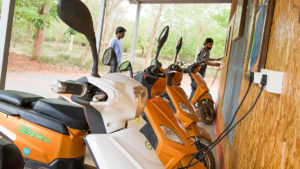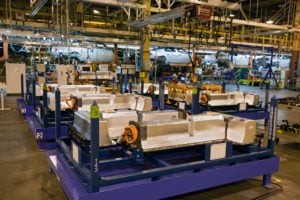India is not a country of cars. People move by rickshaw, scooter, bike, or simply walk. Cars are too expensive for most Indians, let alone electric ones, which are considered a luxury even in rich countries. For comparison, while 95% of American households own a car, India counts only 30 registered cars per 1,000 people. This means it needs a different strategy to decarbonise its mobility systems. Public transportation, with a focus on electric buses, offers the opportunity to target a greater number of passengers cheaply.
State-owned bus corporations are taking baby steps to expand their fleets of electric buses. By the end of the 2019-20 fiscal year an estimated 1,100 e-buses (5,595 units sanctioned under FAME II, including mini e-buses) were on Indian roads. This number may more than quadruple by the end of 2021-22.
In 2015, the federal government launched its Faster Adoption and Manufacturing of Hybrid and Electric Vehicles (FAME) scheme to subsidise electric two- and three-wheelers, hybrid and electric cars, and buses.
In 2019 a scaled-up version, FAME II, was announced. This provided upfront incentives for electric vehicle purchases and supported the development of charging infrastructure.
Nudging demand for e-buses
The right government interventions can help to quickly decarbonise public transport. India has successfully done this in the recent past. In the early 2000s in the National Capital Region (NCR) – which spans Delhi and its satellite cities – all public buses changed from diesel to the less-polluting compressed natural gas (CNG) fuel.
The state of West Bengal demonstrates that this is still possible. The West Bengal Transport Corporation acquired, and is operating, a fleet of 80 electric buses. It is already considering doubling the number in the near future.
Other state governments, including Delhi (300), Goa (150), Chandigarh (80), Uttar Pradesh (700), Tamil Nadu (2,000) and Gujarat are also electrifying a small portion of their fleet.
Rohit Srivastava, vice president for the buses product line at Tata Motors, said: “Globally, electric buses constitute the leading segment within the commercial applications, with almost 20% penetration. Driven by policy promotion and the incentives by the government, the Indian market is also going through a similar trend as the government is focussing on electrification of public transport, in which e-buses have a significant role to play.”
Even before mass EV adoption delivers measurable environmental benefits, electrifying public transport can incentivise the setting up of a charging infrastructure at a much lower cost than cars. But there are multiple complexities that need to be addressed before this can happen.
Total cost of ownership of electric buses
Acquiring and operating an electric bus fleet is not cheap, particularly given the current cost of lithium-ion batteries. Rahul Mishra, a partner at management consultancy Kearney India, said: “If the objective is to reduce carbon footprint, there are several technologies available now.” As well as electric vehicles, these include CNG, liquefied natural gas, fuel cells, hydrogen and more. “At the end of the day, the technology which will make the most economic sense to deploy in public transport will likely see traction,” Mishra said.
![Tata Motors showcase their Starbus electric commercial vehicle at Auto Expo 2018 in Greater Noida, India [image: Alamy]](https://dialogue.earth/content/uploads/2021/05/M513MM.jpg)
Multiple reports and research studies have shown that electric buses can deliver a 15-20% reduction in ownership costs compared with diesel ones. The current surge in fuel prices is only going to further the difference in favour of e-buses.
Charging infrastructure standards
One inherent advantage of buses is that there is a set route. States, therefore, only need to set up charging points at the start and end of journeys. This reduces the need for a large, widespread charging infrastructure that private vehicles would need.
In order to replace fossil fuel-powered vehicles in India, electric buses will need a charging infrastructure that enables long-distance travel. Currently, there are only about 2,000 charging stations across the country, mostly for cars, according to official estimates. They do not follow one specific charging standard.
A charging point is not as simple as a domestic socket which powers home appliances. Charging stations are very diverse, serving vehicles whose charging needs vary from 7 kilowatts (kW) to 350 kW. They are also expensive: a good-quality charging station can cost about USD 350,000. This means that the more buses using a charging point, the cheaper it is per bus.
If a standard is adopted for the charging infrastructure, the country can build a network from the ground up. This would create an economy of scale for e-buses. Otherwise, there is no hope of competing with suppliers from markets like the US, Europe and China. According to a senior source in the automotive industry, who is also advising the government on adopting charging standards, by “building locally based on a standard, we will also be improving value addition and interoperability and then a preowned market can also develop simultaneously without the worry of compatibility of charging infrastructure.”
Huge potential for e-buses
Even though in a post-Covid-19 world most people prefer to travel in their own individual vehicles rather than take public transport, the appeal of sustainable mobility services is said to be at an all-time high, according to a recent survey by Lithium Urban Technologies. The company owns the largest fleet of EVs in the world outside China and is India’s first zero-emission service.
The survey highlights promising sustainable mobility experiments in the city of Bangalore, known as the Silicon Valley of India. It also captures a growing interest in sustainable mobility solutions; 88% of the respondents said they would be more likely to opt for office transportation if it were an EV.
Planning for the long term
Decarbonising India’s polluted cities remains a decades-long prospect. By going electric, Indian transport operators, both state-run and privately owned, can leapfrog internal combustion engine development. This is urgently needed to meet stricter emissions norms.
Due to the country’s transportation landscape, it makes sense to target buses first. They constitute a lifeline for the poor, and are the public transport of choice to reach remote corners of India’s metropolises. Intra-city buses still play an important role in the daily commute for millions of people across Indian cities. A reliable and widespread charging infrastructure will be key in promoting electrification of public transport. This would begin a grassroots movement towards an EV ecosystem.



![Indian father riding on at electric three wheeler with his child [image: Suman Kumar / Alamy]](https://dialogue.earth/content/uploads/2021/05/2BHEFB6-300x200.jpg)
![Phuentsholing Gas Station in Bhutan. Petrol stations create problems of emissions in a country too dependent on cars [image by: Omair Ahmad]](https://dialogue.earth/content/uploads/2020/01/Phuentsholing-Gas-Station-300x225.jpg)



